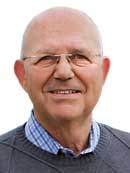Off the Record: From Lotus 1-2-3 on

Photo: Mike Kenna
To think how fast computer technology has progressed is staggering. Managing the resources on golf courses will benefit from each innovation. Technology already guides scheduling tasks for your crew, irrigation or product applications. USGA Deacon and other software like it are beginning a revolution to put it all together in one dashboard.
The name is a tribute to Deacon Palmer’s 50-year stewardship of Latrobe Country Club. Latrobe is where Deacon taught his son, Arnold, to play the game on his way to becoming a beloved sports figure.
At the turn of the 20th century, golf course agronomy was more art than science. There is more science at the turn of the 21st century, but art is still there. We have data, sometimes too much, to help with the decisions made. How are we going to manage big data?
I remember attending the Texas Turfgrass Conference in December 1985. In a golf course session, Jim Moore, a new USGA agronomist, talked about using Lotus 1-2-3 to monitor green speed. This early spreadsheet program was popular in the 1980s. It contributed to the success of IBM PC-compatibles. I am not sure how many superintendents had a PC or used Lotus 1-2-3, but Moore made a strong case with the new technology.
Moore never lost his desire to use computers to help with golf course decisions. He tried for years to convince members or owners that it was time to conserve resources in out-of-play areas. There was a litany of names for these areas — low maintenance, wildlife habitat, environmentally sensitive or native areas, to name a few.
There were hurdles preventing decision-makers at the course from getting on board. How many acres? Do they impact the golfer? Will it save money? Good questions that were difficult to answer without more information. Aerial images of an individual golf course were not available or expensive to get. The release of Google Earth in 2001 helped Moore address the amount of acreage. With Google Earth, Moore provided accurate estimates of greens, tees, fairways and rough, but how would low-maintenance native areas impact the pace of play?
In 2012, the USGA’s effort to understand the pace of play revealed the answer. GPS data loggers given to golfers provided pace-of-play information and showed areas where golfers never enter. Moore now had the data to assign lower-maintenance areas using Google Earth. The superintendent could manage 10 to 30 acres with fewer resources. So, what are the potential savings? Moore now had accurate measurements for all parts of the golf course facility: greens, tees, fairways, bunkers and rough. He designated four levels of rough from closest to the fairway (R1) to rough no one hits into (R4). From R1 to R4, there were decreasing amounts of resources used for maintenance. Getting back to Moore’s prowess with spreadsheets, he created several “what-if scenarios” to compare changes in management or resource usage.
Moore also applied this technique to irrigation zones. For example, tee compounds often have a few large-radius irrigation heads. Golfers do not hit shots from tee surrounds comprising 90 percent of the irrigated area. We could save water by focusing on the tees with smaller radius irrigation heads.
Moore had a modest budget for a software company to develop the resource management tool. Then, the USGA’s Research, Science and Innovation, led by Matt Pringle, Ph.D., got involved. Agronomists, engineers and programmers worked together on a helpful decision tool.
The USGA acquired GPS shape files used for yardage estimates on smartphones and other devices. Regional surveys to gauge labor, fuel and water costs provided a starting point for each course. By 2015, the components needed for the tool were in place, with several refinements along the way.
USGA Deacon provides data-driven facility management decisions that help make the game more affordable and enjoyable. USGA Deacon and similar decision tools or software are just the beginning of the big-data technology revolution for the game of golf. As the song goes, the best is yet to come!











